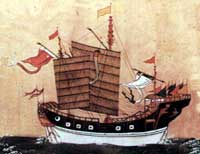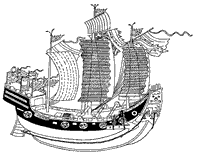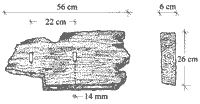 |
| Turiang |
16 Mar 2001
|
|||
| Last modified: 16 Mar 2001 |
 It
is almost certain that ship design in the region changed significantly at around
the time of the Ming ban of AD 1371.
Ships plying the South China Sea before this event can be clearly distinguished
as of either traditional Chinese or Southeast Asian design. Shipwrecks discovered
in the South China Sea and dating from the 15th and 16th century have been of
a later hybrid design which combined elements from these two original types.
While there is reason to believe that the first merger of design elements occurred
in Java, which adopted transverse bulkheads following the Mongol intervention
of AD 1293, it appears to have been only after AD 1371 that Chinese shipbuilders
adopted Southeast Asian features.
It
is almost certain that ship design in the region changed significantly at around
the time of the Ming ban of AD 1371.
Ships plying the South China Sea before this event can be clearly distinguished
as of either traditional Chinese or Southeast Asian design. Shipwrecks discovered
in the South China Sea and dating from the 15th and 16th century have been of
a later hybrid design which combined elements from these two original types.
While there is reason to believe that the first merger of design elements occurred
in Java, which adopted transverse bulkheads following the Mongol intervention
of AD 1293, it appears to have been only after AD 1371 that Chinese shipbuilders
adopted Southeast Asian features.
The Quanzhou wreck which sank in the later part of the 13th century is a typical example of a traditional Chinese vessel. Built of fir with bulkheads, she was joined by iron clamps, a common feature seen on early Chinese vessels. No wooden dowels, which would have been used in contemporary Southeast Asian vessels, were present.
The Pandanan wreck lost in the mid 15th century in the Philippines represents a relatively pure Southeast Asian vessel. Although divided into Chinese-type cargo compartments, separated by means of transverse bulkheads, she was joined with wooden dowels, with no iron nails of any kind. Like most Southeast Asian and hybrid vessels, she was built of tropical hardwood.¹
 The
Bukit Jakas wreck off Bintan Island in Indonesia, also dated to the mid-15th
century by carbon 14 and one ceramic shard, is representative of the hybrid
vessels which mixed the two traditional design elements and have recently become
known as 'South China Sea' ships. On this wreck, the excavators found
planks joined with wooden dowels, but frames fastened by square iron nails.
Tropical hardwood was again the main construction material.²
The Royal Nanhai and the Longquan are of this type.
The
Bukit Jakas wreck off Bintan Island in Indonesia, also dated to the mid-15th
century by carbon 14 and one ceramic shard, is representative of the hybrid
vessels which mixed the two traditional design elements and have recently become
known as 'South China Sea' ships. On this wreck, the excavators found
planks joined with wooden dowels, but frames fastened by square iron nails.
Tropical hardwood was again the main construction material.²
The Royal Nanhai and the Longquan are of this type.
From the limited investigation of the Turiang, it is almost certain that no wooden dowels were used. Instead, a number of 14mm square holes have been seen, surrounded by oxide stains, confirming the use of iron nails. The two transverse bulkheads near the surface had collapsed and prevented proper measurements. The distance between them varied between 1.10 and 1.25 metres. The thickness of these decomposed bulkheads was about 60 mm, but is likely to have been thicker at the time of construction.
A few bottom planks located in the aft and shallowest part of the site varied between 22 and 24 centimetres in width and had the same thickness as the bulkheads. None of these planks had any signs of drilled holes or associated wooden dowels. Sacrificial planks, often added annually to the hull to compensate for attacks by woodworm (as in the Quanzhou wreck), could not be seen. The lack of sacrificial planking may indicate that the vessel was relatively new when lost.
 An
original piece of wood sent for identification failed because of the decomposed
state of the sample. A second attempt, using branch growth within the same piece
of bulkhead, confirmed that the wood belonged to one of four possible types
of temperate-climate softwood. Further analysis of cross and tangential sections
and investigation of resin canals showed with some certainty that the samples
were Pinus sp., or pine.³ This tree grows in China,
Laos and northern Vietnam. It does not grow in Thailand or farther south. Amongst
the vessels mentioned above, it is notable that the two Chinese ships, the Turiang
and the Quanzhou wreck, are built from temperate-climate wood, and all
the later Southeast Asian and South China Sea vessels are built from tropical
hardwood.
An
original piece of wood sent for identification failed because of the decomposed
state of the sample. A second attempt, using branch growth within the same piece
of bulkhead, confirmed that the wood belonged to one of four possible types
of temperate-climate softwood. Further analysis of cross and tangential sections
and investigation of resin canals showed with some certainty that the samples
were Pinus sp., or pine.³ This tree grows in China,
Laos and northern Vietnam. It does not grow in Thailand or farther south. Amongst
the vessels mentioned above, it is notable that the two Chinese ships, the Turiang
and the Quanzhou wreck, are built from temperate-climate wood, and all
the later Southeast Asian and South China Sea vessels are built from tropical
hardwood.
Due to scattered surface ceramics, the wreck outline was difficult to measure. Electronic mapping of the wreck and its nearest perimeter indicated a pottery site of eighteen by seven metres. This type of acoustic measurement, which records hard reflectors on the seabed, does not have any penetration capability and can only detect surface remains. Experience with measurements of this type suggests that the overall length of the vessel could have been around twenty-six metres.
Plans for further excavation and research include further analysis of remaining ship's timber, and an attempt to identify the place of construction and any local shipbuilding features. (For example, Guangdong junks are known to have used different wood in different sections of the keel; mast steps, often made of tropical hardwood, may give additional information.)
| Turiang overview | Maritime Asia homepage | Next: ceramic issues |